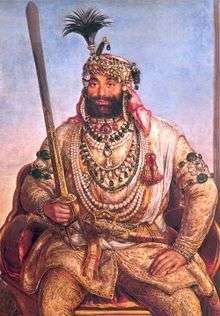Maharaja Ranjit Singh's throne


Maharaja Ranjit Singh's throne was made by the goldsmith Hafez Muhammad Multani about 1820 to 1830. Made of Wood and resin core, covered with sheets of repoussé, chased and engraved gold.[1]
Overview
It shows the splendour of Ranjit Singh's court and is decorated with richly worked sheets of gold. The distinctive cusped base of this throne is composed of two tiers of lotus petals. The lotus is a symbol of purity and creation and has traditionally been used as a seat or throne for Hindu gods. However, the octagonal (eight-sided) shape of the throne is based on courtly furniture of the Mughals. Their many-sided furniture provided models for thrones, footstools and tables throughout northern India. It is thought that as the Maharaja was renowned for the simplicity of his appearance and dislike of ceremony he rarely sat on this throne, preferring to sit cross-legged on carpets.
The throne was part of the State Property taken by the British in 1849 on the annexation of Punjab, after the Second Anglo-Sikh War, and was displayed with other treasures of the British Empire at the Great Exhibition in 1851. It is kept in the V&A Museum with inventory number 2518(IS).
Bibliography
- Jackson, Anna (ed.) (2001). V&A: A Hundred Highlights. V&A Publications.